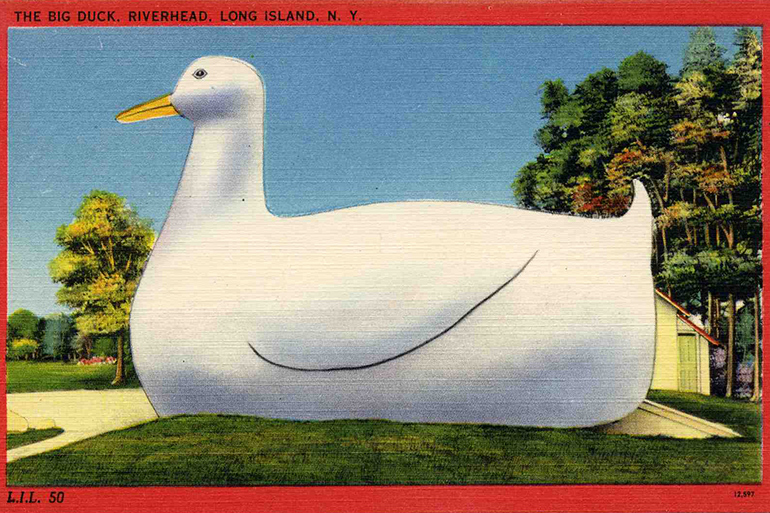Before Linda Scott’s 'Stargazer,' There Was Martin Maurer’s Big Duck

Today the unofficial entrance to the Hamptons is the big, 50-foot tall red sculpture in a farm field on the eastern side of County Road 111 in Manorville. You come down that road from the Long Island Expressway and there it rises, Stargazer, a soaring image of an abstract deer looking toward the sky while grasping what appears to be a branch of a tree in its mouth.
“Are we there yet?” comes the call from the back seat of the car. “We’ve just entered the Hamptons,” comes the reply from the front seat.
The late Linda Scott created this sculpture. It had originally been commissioned by the Animal Rescue Fund for its driveway across from the East Hampton Airport. But it never got erected, after the town complained. Legends include that it was so tall, incoming aircraft might be distracted flying over it. It would need to find a new home. The friendly owner of a sod farm in Manorville answered the call.

Stargazer was erected in 1991. But this story is about the iconic sculpture that marked the entrance to the Hamptons for the half-century before that, a sculpture of a white duck, 20 feet high, on a different entry road in a different time—because one of the main entry roads in those years was not at Manorville, but on Flanders Road, Route 24, between Riverhead and Hampton Bays. The Long Island Expressway had not yet been completed. It ended at Smithtown. And from there, Route 25 took you through the farm fields to Riverhead and the Hamptons. And there was the duck, the answer to the question, “Are We There Yet?”
At this earlier time, you didn’t whiz by in your car as you do at Stargazer. Back then, you got to the Big Duck and you stopped and took a picture of everybody in the car standing in front of it. You might even buy what was on sale inside of it. It was a store. Then you’d drive on.

Furthermore, the Big Duck is still there in Flanders. It’s just that Flanders Road is now a secondary road, so you might not have even seen it. It’s part of a museum now, and you can take kids to it, admire it and go inside—the results of a duck farmer’s dream.
Personally, when my dad and mom drove out to the Hamptons with my sister and me in 1956 for the first time, we stopped there at the Big Duck. I was 16 in 1956. My sister was 9. We had lived our early years in a New Jersey suburb and were now coming out to Montauk because dad had bought the White’s Pharmacy in Montauk. We went inside the duck—it was a small retail space with a counter, curved walls and ceilings painted white—bought a cut-up roasted duck there and ate it at a picnic table, with the Big Duck looking down upon us. Mom said we were almost in the Hamptons now.
The Big Duck had been built in 1931 on Sound Avenue at the Puglsley Duck Farm, in what was then called the Upper Mills section of Riverhead. The idea to do it came from Martin Maurer, the co-owner of that farm, and his wife, Jeule. As the Depression was now heating up, the farm was not thriving, and so Martin and Jeule took the opportunity to get in their Ford Model A and drive off to tour America.
On the way to Los Angeles, they saw numerous roadside buildings in the shape of the business going on inside. For example, they ate hot dogs by walking into a giant puffy hot dog bun with mustard and sausage on the roof. It was a fad doing that out west at that time. Thus, one day, drinking coffee inside a coffee percolator, Martin asked, why don’t we build a giant duck back home? And so, when they got home, they did.
Drawing up plans for it was George Reeve, an architect with an office in Calverton. He studied a chicken skeleton after a big family dinner to get the design right. From those plans, a Broadway set designer named William Collins, who had a vacation home in Manorville with his brother Samuel, built a wood frame 30 feet long, 15 feet wide and 20 feet tall, over which the two of them unrolled and attached a wire mesh. From that, the builders Smith & Yeager of Riverhead did the graceful curving masonry work inside and out over the mesh, and the whole thing was painted white, with the beak painted orange.

A brilliant solution was decided upon for the eyes. Two Ford Model T taillights were obtained and placed in the head. Wires went to a gas-driven generator. Turn it on and the eyes glowed red.
Most of the information in this story can be found in an excellent new book just published by Dr. Susan Van Scoy called The Big Duck and Eastern Long Island’s Duck Farming Industry. Other details are from my own personal encounters with the duck over the years.
It was a proud, beautiful big duck, and it sat roadside on Sound Avenue in front of the farm. Sound Avenue was the main road heading out the North Fork back then. Maurer thought this was so neat, he filed for and got a trademark for it in 1932, the year after it was first put out front. No one else should make one.
He bought ads in the newspapers. “Freshly Killed Ducklings—Broilers—Fryers—Young Roasters Dressed Ready for the Oven” was the copy.
In 1936, Maurer and his wife parted ways from his partner P.W. Meyer and bought their own duck farm on Flanders Road on the way from Riverhead to the Hamptons. When they left Calverton, they took the Big Duck on a trailer with them. It did even more business on Flanders Road, the gateway to the Hamptons, than it had on Shore Road, the gateway to the North Fork.
In 1951, nearly 20 years later, the Maurers retired and moved to Florida. The farm and the Big Duck were sold to Leonard Desson and his family. Len and his boys ran the duck farm and his wife, Maude, worked behind the counter from 8 a.m. to 8 p.m. every day. Other buildings on the property included the rooster house, the young stock house, the broilers house, the garden house, the battery house, the farmhouse, the manure house, the tool shed, the garages and the killing room. The houses were numbered. Everyone would know where everyone else was if they mentioned the number.

Jean and Mario Colombo bought the place in 1972, adding an antique shop, a sandwich shop and a “gingerbread house” that sold cookies. By late in the 1970s, however, the Expressway was completed, linked to Sunrise Highway and the Hamptons, and the Flanders Road entry became a backwater. Also, duck farming was in serious decline. It was a messy business, and the farms backed onto the wetlands of bays so excrement would be washed away in the tides.
Soon there would be virtually no more duck farms. In 1982, the Colombos sold the property to Kia and Pouran Eshghi, new immigrants from Iran who wanted to convert the property into a group of residences for artists. The effort foundered, however, and for a number of years the buildings on the property lay idle and in decay. With that, the Eshghis got an option from developers who wanted to just make it a residential development. The Big Duck would have to be moved off, or, worse, torn down. Time was of the essence.
As a result, the Suffolk County Division of Historic Services and Friends for Long Island’s Heritage led protests and demonstrations. Protestors at the Duck carried signs reading SAVE THE BIG DUCK, and, in the end, the Eshghi family gave the Big Duck to Suffolk County to move off. On January 27, 1988, the County had it towed down Flanders Road for four miles to a pony ride stable and pasture they had on land they owned at the edge of Sears Bellows County Park. The Big Duck was on wheels surrounded by a big parade of local citizens walking along—me among them—on January 27, 1988. It took all of that very cold day to do it.
It then became a relatively easy matter to restore the Big Duck and turn it into a tourist attraction. No broilers or fresh killed ducks or eggs were available now. Just some brochures that described the Big Duck and how soon they hoped to have a whole lot of historic old businesses in the shape of different things on the property as a walk through museum.

Supermodel Christie Brinkley of Bridgehampton was persuaded to make a recording urging people to stop at the Big Duck that first year. The recording was about two minutes long and it was broadcast by the county only over a low-power FM station they created for that purpose. You could begin to hear her a quarter-mile away from the duck in both directions. Signs alerted you to that fact. Turn to 88.6 on your radio dial and hear all about it. Stop in if you want. That half a mile was the sum total of the broadcast, which was repeated over and over again on a loop. She was appropriately breathless, smart and lively as she began “The Big Duck, which you will soon see on a short way up this road…” and then came the rest of the tale.
Another move took place some years later. The proposed museum had not materialized. And also the development at the original Flanders Road location on the former farm had fallen through. As a result, the Town of Southampton, using CPF money, bought the old location to save the land and return the Big Duck to its traditional home. And so another Big Duck parade took place in 2007, going back the other way. Today it again stands facing the road while behind, two historic barns act as a support group.
For more information on the Big Duck, visit bigduck.org.




